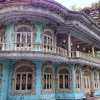
Time Museum of Tehran is a magnificent mansion in the north of the capital of Iran, which is located in Zafaraniyeh street. The construction of this mansion backs to the time of Mohammad Shah and Naser al-Din Shah Qajar. The mansion is in fact a historical house which is also known as the House of Hossain Khodadad, Clock Museum, and Time Museum. The mansion was first located in Ferdows Garden and was owned by Moayyer ol-Mamalek, Naser al-Din Shah’s son-in-law.
The building of Time Museum has been erected in an area of five hectares and built-up area of the building is 700 square meter. Currently, it includes two stories, although it was a one-floor building at the time of its construction. The building was bought by a person, named Hossain Khodadad, in 1963, who was a craftsman and entrepreneur. He decided to strengthen the building and he added another story to it. Khodadad was passionate to the Persian stucco art and, for this reason, he invited the most experienced masters of stucco decoration from different cities to create a masterpiece in his home. The work lasted 12 years and it was finished one year before the Islamic Revolution of Iran. Therefore, the owner could not stay in the house for long, because his properties were seized by Mostazafan Foundation in the next year and the house was converted into a public place. Despite this, the signs of this taste are still visible everywhere in the house, for example in the spectacular Isfahani Room where a panel named Creation has been created using the subtle art of Persian stucco. This artwork is formed inspired by the Music Hall in Aali Qapu Palace, Isfahan, depicted in the Safavid Style of stucco art.
Time Museum presents a unique collection of timing and chronometry over time. It shows, for the first time in Iran, the evolution process of the human thinking about time from ancient time to the present. In this museum, different types of clocks are divided into some general categories: mechanical clocks including weight and wind clocks, portable clocks such as pocket clocks and watches. The first floor of museum is dedicated to mechanical clocks in different models of standing, wall and niche clocks. The second floor exhibits the usual pocket clocks and those which have been made for the historical or political figures. A variety of calendars, related to different periods of time, are also shown in some part of Time museum. Jalali Calendar and its history in Iran is one of the main subjects of this part. The court yard of the museum provides an attractive place for exhibiting basic forms of clocks including Sundial, Water Clock, Hourglass and fuel clock. Interesting about this place is a focus on the importance of decorating these horological devices, based on the taste and style of each period. So that, we can see the advent of Arabesque ornament and other Islamic symbols, during the Islamic era.
Remarkable among the displays of this museum are: Falcon Clock, Cuckoo Clock, the first attendance device in Iran, related to the railroad which entered to Iran about 80 years ago, a clock for watch shift, ship clock, two-time zone clock, and candle clock. The last one has been made as a graduated candle in which each burnt section indicates the passage of one hour of time. It is stated that Alfred the Great, King of the British Empire, devised this kind of clock, about 1000 years ago. A pocket clock baking to 300 years ago is another interesting object in the Time Museum. Originally from Germany, these kinds of clocks were first made in pendant form and were very light to hang around the neck. However, when the waistcoat became popular, people preferred to put this kind of clock in its pocket.
The house of Hossain Khodadad was inscribed on the list of Iran National Heritages in 2003 (Registration Number: 10868). This museum is open to public all days of week, from morning till evening. Admission to the museum-garden is free and tickets are only required for visiting inside the building. The best time for visit this museum is spring. If you travel to this northern part of the capital, it is recommended to visit other adjacent unique sights like Cinema Museum of Iran, Niavaran Museum and Saadabad Museum, too.